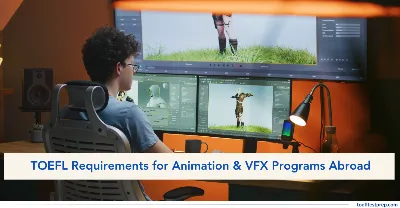How to Tackle TOEFL iBT® Reading Sentence Insertion Questions

" In TOEFL reading sentence insertion tasks, you are required to arrange a new sentence in the paragraph where it makes the most sense. These tests evaluate your understanding of paragraph organization, text coherence, and idea flow."
Key Highlights
Wondering how to answer TOEFL Reading sentence insertion questions? Well, sentence insertion questions in TOEF reading sentences test a candidate's ability to understand the proper coherence and logical flow of a text. A new sentence will be given in it, and the candidate has to identify where in the paragraph of the provided passage it should be most logically inserted. Although it sounds easy, it can be a bit tricky since you have to try all the options and determine the best fit. So, let's explore some effective strategies to help you tackle sentence insertion these questions confidently.
Struggling with reading comprehension?
Check out our TOEFL Reading Practice Tests to boost your skills and ace the exam!
How to Answer TOEFL Reading Sentence Insertion Questions
Here are some expert tips to help you answer TOEFL Reading iBT sentence insertion questions accurately and quickly:
1. Understand the Question Type
Sentence insertion questions will provide you with a new sentence and ask you for the place where this sentence should come in a given paragraph.
Example:
‘The following sentence can be added to the passage: 'This discovery revolutionized the field of astronomy.' Where would it best be inserted?’
The paragraph will then be shown with four squares [■] marking potential insertion points:
‘The telescope was invented in the early 17th century. [■] Galileo Galilei was one of the first to use it for astronomical observations. [■] He observed the moons of Jupiter and the phases of Venus. [■] These observations provided strong evidence for the heliocentric model of the solar system. [■]’
You will be given a passage and a series of square options [■]; your task is to choose the square that you would most logically want to put in the new sentence.
2. Read the Given Sentence Carefully
Read the sentence's content. Analyze its tone and what signal words or transitions have been given. See how it may relate to the text around it.
Example: Given sentence: ‘However, this theory was not widely accepted until the 1960s.’ Analysis:
- Content: Discusses a theory and its acceptance
- Tone: Somewhat opposite of what was given before
- Signal word: ‘However’ (contrast)
- Time reference: ‘1960s’ (states a specific period)
3. Skim the Paragraph
This provides the reader with an overview of the paragraph, an idea of the main topic, and how ideas progress. It lets you know what the general theme is and what major points to look out for.
Example: ‘The Big Bang theory was first proposed in the 1920s by Georges Lemaître. [■] It suggested that the universe began from a single point and has been expanding ever since. [■] This idea was revolutionary at the time. [■] Today, it is widely accepted by the scientific community. [■]’
Main topic: Formulation and acceptance of the Big Bang Theory.
Structure : Proposal → Explanation → Initial reception → Current status
Check out - TOEFL iBT® Reading Tips: How to Read Complex & Long Sentences
4. Look for Logical Connections
The additional sentence should make sense with the sentences preceding and following it, as one has to be careful not to disturb the paragraph's logical progression.
Before: The Big Bang theory was first proposed in the 1920s by Georges Lemaître.’ Inserted sentence: However, this theory was not widely accepted until the 1960s.’
Inserted sentence: ‘However, this theory was not widely accepted until the 1960s.'
After: Today, it is widely accepted by the scientific community.
Here, this sentence has maintained chronological order and systematically represented the gradual acceptance of the theory.
5. Check for Pronoun References
If the sentence uses pronouns like 'it,' 'they,' or 'this,' then it must refer back clearly to something else in the paragraph.
Example: Scientists discovered a new species of frog in the Amazon rainforest. [■] It has a unique mating call that can be heard for miles. [■] Inserted sentence: This discovery excited biologists worldwide.
Clearly, 'This discovery' here refers to the new species of frog.
6. Pay Attention to Transition Words
Transitions words like 'however,' 'furthermore,' or 'consequently' sometimes can be used to see what place the sentence would logically fit in the flow of ideas in the paragraph.
Example: Solar energy has become increasingly popular. [■] Many homeowners are installing solar panels. [■] The cost of installation remains high for some. [■]
Inserted sentence: Nevertheless, government incentives are making it more affordable.
The transition word 'Nevertheless' means it is a contrast sentence, so it should come after the cost has been mentioned.
7. Consider Chronological Order
Make sure that the sentence you insert does not disturb the chronology of the events in the paragraph.
Example: The Industrial Revolution began in the late 18th century. [■] It led to significant technological advancements. [■] By the mid-19th century, factories were common in many countries. [■]
Inserted sentence: In the early 19th century, steam power became widely used in manufacturing.
This sentence should be placed between the first and last sentences to maintain chronological order.
8. Eliminate Obvious Mismatches Rule
Sometimes, it is possible to very easily rule out one or two options that do not make any sense in terms of the content or logic.
Example: Paragraph about photosynthesis in plants: ‘Plants absorb sunlight through their leaves. [■] This energy is used to convert carbon dioxide and water into glucose. [■]" Inserted sentence: ‘Marine mammals, such as whales, can dive to great depths.’
This sentence on marine mammals clearly does not fit in a paragraph about photosynthesis by plants.
Check out - How to Answer TOEFL iBT® Reading Inference Questions
9. Read the Paragraph Again
Make sure the paragraph still flows and makes sense with the new sentence included.
Example: The Mona Lisa is a famous painting. It was created by Leonardo da Vinci. The painting hangs in the Louvre Museum in Paris.
With insertion: The Mona Lisa is a famous painting. It was created by Leonardo da Vinci. The artwork is known for its enigmatic smile. The painting hangs in the Louvre Museum in Paris.
Read it aloud to see that it sounds natural and that there is a logical flow.
10. Practice with Various Passages
The more you practice, with different topics, and different writing styles, the better you'll be at recognizing where sentences fit most appropriately.
Example: Practice with passages from various fields like History, Science, Art, and Social Studies.
Applying these techniques consistently and practing ng with different passages will help you enhance your performance on TOEFL Reading sentence insertion questions. You will find more ease and confidence when answering such questions in no time. Good luck with your TOEFL prep!
Also Read:
Featured Articles

TOEFL Format Undergoing Significant Changes in January 2026
The TOEFL iBT format is changing in January 2026 with a smarter structure and easier scoring. Here’s everything you need to know to stay ahead.
August 06, 2025
Minimum TOEFL Score Requirement for South Korea Student Visa
Understand the TOEFL requirement for a South Korea student visa and English-taught programs, and prepare your application for success.
September 14, 2025
Minimum TOEFL Score for Study Visa in Poland
Understand TOEFL score requirements for securing a Poland student visa and joining top universities offering English-taught programs.
September 14, 2025
TOEFL Requirements for Animation & VFX Programs Abroad
Discover TOEFL score requirements for studying Animation and VFX abroad, and learn how to meet them for top creative universities.
September 14, 2025